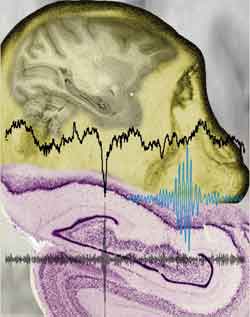Neural Interaction in Periods of Silence

Hippocampal oscillations: Neural Interaction in Periods of Silence such as deep sleep.<br><br>Nikos Logothetis / Max Planck Institute for Biological Cybernetics.
While in deep dreamless sleep, our hippocampus sends messages to our cortex and changes its plasticity, possibly transferring recently acquired knowledge to long-term memory. But how exactly is this done?
Scientists from the Max Planck Institute for Biological Cybernetics have now developed a novel multimodal methodology called “neural event-triggered functional magnetic resonance imaging” (NET-fMRI) and presented the very first results obtained using it in experiments with both anesthetized and awake, behaving monkeys. The new methodology uses multiple-contact electrodes in combination with functional magnetic resonance imaging (fMRI) of the entire brain to map widespread networks of neurons that are activated by local, structure-specific neural events.
Many invasive studies in nonhuman primates and clinical investigations in human patients have demonstrated that the hippocampus, one of the oldest, most primitive brain structures, is largely responsible for the long term retention of information regarding places, specific events, and their contexts, that is, for the retention of so-called declarative memories. Without the hippocampus a person may be able to learn a manual task over a period of days, say, playing a simple instrument, but –remarkably – such a skill is acquired in the absence of any memory of having practiced the task before.
The consolidation of declarative memory is thought to occur in two subsequent steps. During the first step, the encoding phase, hippocampus rapidly binds neocortical representations to local memory traces, while during subsequent “off-line” periods of calmness or sleep the new traces are concurrently reactivated in both hippocampus and cortex to strengthen the cortico-cortical connections underlying learned representations. But what is the neural basis of this hippocampal-cortical dialog, and how does hippocampus communicate with the rest of the brain?
For the very first time, Nikos Logothetis, director of the Department for Physiology of Cognitive Processes at the Max Planck Institute for Biological Cybernetics and his team used so-called neural event triggered functional magnetic resonance imaging (NET-fMRI) in both anesthetized and awake, behaving monkeys to characterize the brain areas that consistently increased or decreased their activity in relationship to a certain type of fast hippocampal oscillations known as ripples. Ripples occur primarily during deep sleep and can be measured with electrophysiological methods. Using intracranial recordings of field potentials, the scientists demonstrated that the short periods of aperiodic, recurrent ripples are closely associated with reproducible cortical activations that occur concurrently with extensive activity suppression in other brain structures.
Interestingly, structures were suppressed whose activities could, in principle, interfere with the hippocampal-cortical dialog. The suppression of activity in the thalamus, for instance, reduces signals related to sensory processing, while the suppression of the basal ganglia, the pontine region and the cerebellar cortex may reduce signals related to other memory systems, such as that underlying procedural learning, for example riding a bicycle.
The aforementioned findings offer revealing insights into the large-scale organization of memory, a cognitive capacity emerging from the activation of widespread neural networks which were impossible to study in depth before now using either functional imaging alone or traditional single neuron recordings. Capacities such as perception, attention, learning and memory are actually best investigated using multimodal methodologies such as the NET-fMRI method employed in the MPI study. It is difficult to overstate the importance of the study of the neural mechanisms underlying such capacities, as the vast majority of neurological failures actually reflect dysfunctions of large-scale networks, including cortical and subcortical structures.
Original Publication:
Logothetis, N.K., Eschenko, O., Murayama, Y., Augath, M., Steudel, T., Evrard, H.C., Besserve, M., Oeltermann, A. (2012) Hippocampal-cortical Interaction during Periods of Subcortical Silence. Nature, doi: 10.1038/nature11618
More Information about the research of Nikos Logothetis: http://www.kyb.tuebingen.mpg.de/research/dep/lo.html
Contact:
Prof. Dr. Nikos Logothetis
E-mail: nikos.logothetis@tuebingen.mpg.de
Stephanie Bertenbreiter (Public Relations)
Phone: +49 7071 601-1792
E-mail: presse-kyb@tuebingen.mpg.de
The Max Planck Institute for Biological Cybernetics works on the elucidation of cognitive processes. It employs about 300 people from more than 40 countries and is located at the Max Planck Campus in Tübingen, Germany. The Max Planck Institute for Biological Cybernetics is one of 80 research institutes that the Max Planck Society for the Advancement of Science maintains in Germany and abroad.
Media Contact
All latest news from the category: Life Sciences and Chemistry
Articles and reports from the Life Sciences and chemistry area deal with applied and basic research into modern biology, chemistry and human medicine.
Valuable information can be found on a range of life sciences fields including bacteriology, biochemistry, bionics, bioinformatics, biophysics, biotechnology, genetics, geobotany, human biology, marine biology, microbiology, molecular biology, cellular biology, zoology, bioinorganic chemistry, microchemistry and environmental chemistry.
Newest articles

Largest magnetic anisotropy of a molecule measured at BESSY II
At the Berlin synchrotron radiation source BESSY II, the largest magnetic anisotropy of a single molecule ever measured experimentally has been determined. The larger this anisotropy is, the better a…

Breaking boundaries: Researchers isolate quantum coherence in classical light systems
LSU quantum researchers uncover hidden quantum behaviors within classical light, which could make quantum technologies robust. Understanding the boundary between classical and quantum physics has long been a central question…

MRI-first strategy for prostate cancer detection proves to be safe
Active monitoring is a sufficiently safe option when prostate MRI findings are negative. There are several strategies for the early detection of prostate cancer. The first step is often a…



